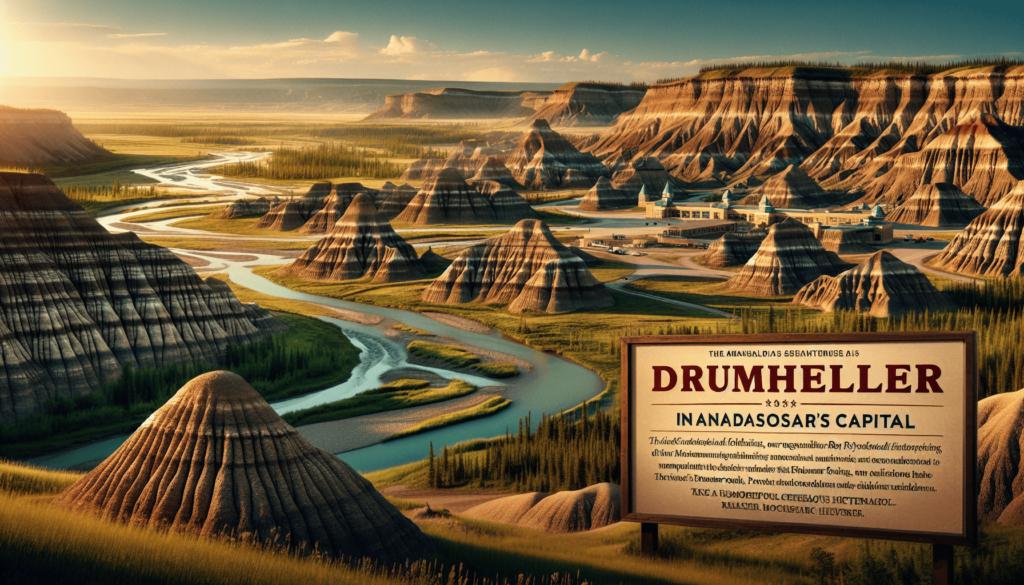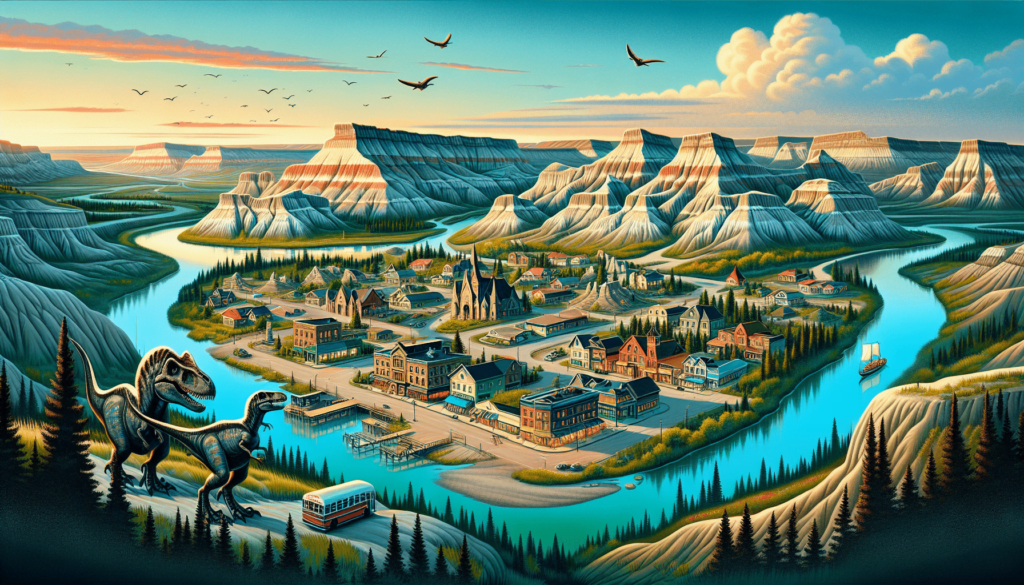Drumheller in the Badlands of Alberta, Canada, is known as the “World Capital of Dinosaurs.” This small town, with a population of just under 8,000, is home to some of the most important fossil discoveries ever made. Located in an extraordinary badlands topography, where dinosaur bones are commonly seen poking out of the earth, Drumheller is the epicentre of dinosaur research and exploration. Attracting over 430,000 visitors annually, the Royal Tyrrell Museum of Palaeontology showcases the region’s most astonishing discoveries and offers a glimpse into the rich prehistoric past of this dinosaur hotspot. With its unique geological features and abundant fossil findings, Drumheller is truly a haven for paleontologists and dinosaur enthusiasts alike.

Table of Contents
Introduction
Drumheller, located in the Badlands of Alberta, Canada, proudly holds the title of the “World Capital of Dinosaurs.” This small town, with a population of 7,968, has become renowned for its significant fossil discoveries. Alberta, Canada, is home to the largest deposits of dinosaur fossils on Earth, and Drumheller is at the heart of it all.
The Royal Tyrrell Museum of Palaeontology, a globally recognized natural history museum and research center, showcases some of the region’s most astonishing finds. In this article, we will explore Drumheller’s claim to fame as the world capital of dinosaurs, the geological history of the area, remarkable discoveries made there, the importance of Dinosaur Provincial Park, the history of dinosaur fossil discoveries, and the enduring fascination with dinosaurs.
Drumheller: Canada’s Dinosaur Capital
Drumheller proudly proclaims itself as the “World Capital of Dinosaurs,” and for good reason. Located in the Badlands of Alberta, Canada, Drumheller is home to some of the most important fossil discoveries ever made. The region’s abundance of dinosaur fossils has earned it this prestigious title. The Royal Tyrrell Museum of Palaeontology, located in Drumheller, plays a significant role in showcasing and preserving these remarkable discoveries. With over 430,000 visitors annually, the museum draws attention to the rich dinosaur heritage of the area.
The Geological History of Drumheller
Drumheller’s landscape has undergone significant changes over time, contributing to its current status as a dinosaur fossil hotspot. Approximately 75 million years ago, the area looked entirely different from its current badlands terrain. It was a semi-tropical coastal plain that provided ideal conditions for a diverse range of life, especially dinosaurs.
These ancient creatures thrived on the abundance of plant life and other creatures found in the region. The geological conditions during this time period were also conducive to the preservation of dinosaur fossils. Seasonal storms and floods killed dinosaurs in large numbers and quickly buried their remains under layers of sediment. Water played a crucial role in this fortuitous cycle of events, creating the perfect conditions for preservation and fossilization.
Remarkable Discoveries in Drumheller
Drumheller has been the site of several remarkable dinosaur discoveries that have contributed to our understanding of these ancient creatures. One notable discovery is the T-Rex known as “Black Beauty,” which was found by two schoolboys fishing in the Crowsnest River. The distinct black color of its bones, attributed to manganese in the groundwater during fossilization, sets it apart. The Royal Tyrrell Museum houses a large volume of specimens, including an ornithomimosaur fossilized in a death pose. This particular specimen provided the first hard evidence of feathers on this dinosaur group, shedding light on their appearance.

Dinosaur Provincial Park
Dinosaur Provincial Park, located 170km southeast of Drumheller, is a UNESCO World Heritage site renowned for its abundance and diversity of dinosaur fossils. The park boasts over 50 dinosaur species, 150 complete skeletons, and 450 fossilized organisms. It attracts over 100,000 visitors annually, offering guided tours to notable sites such as a vast dinosaur bone bed where a herd of horned Centrosaurus met their tragic demise while attempting to cross a swollen river. This park serves as a testament to the rich dinosaur heritage of Alberta, with unparalleled fossil discoveries.
History of Dinosaur Fossil Discoveries
Dinosaur fossil discoveries in Alberta have a rich history, intertwined with the indigenous Blackfoot First Nations and the arrival of French trappers. The Blackfoot people, who first encountered the fossils, revered them as the “grandfathers of the bison,” their most sacred animal. French trappers, in search of beaver pelts for top hat production, learned of the treasures buried in the ground from the Blackfoot people. This sparked widespread interest, leading to the Great Canadian Dinosaur Rush in the early 1900s. The rush prompted numerous fossil-hunting expeditions, eventually putting Alberta on the map as a leading dinosaur fossil hotspot.
Continued Fascination with Dinosaurs
The enduring fascination with dinosaurs stems from their unique place in Earth’s history and their relevance to our future. Despite their extinction millions of years ago, dinosaurs continue to captivate scientists and the general public alike. The study of dinosaurs provides insights into the evolution of life on Earth and helps us understand our own place in the natural world. Additionally, the extinction events that wiped out the dinosaurs serve as cautionary tales for humanity, reminding us of the potential consequences of environmental changes and the importance of preserving our planet.
In conclusion, Drumheller, Canada’s self-proclaimed “World Capital of Dinosaurs,” holds a significant place in the field of paleontology. Its unique badlands topography and geological history have yielded remarkable fossil discoveries that continue to fascinate and educate people around the world. The Royal Tyrrell Museum and Dinosaur Provincial Park play crucial roles in showcasing and preserving these important finds. The enduring fascination with dinosaurs serves as a reminder of the fragility of life on Earth and the lessons we can learn from its history.
Related site – Drumheller
